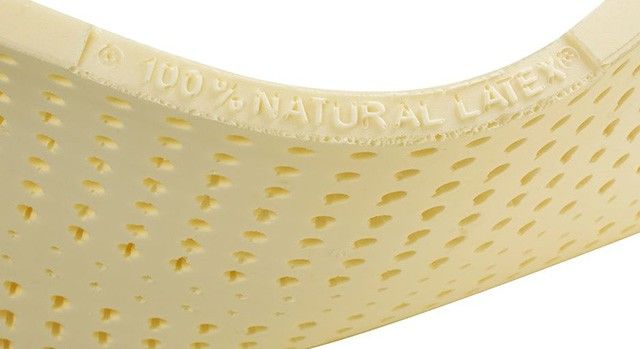Natural latex is one of the most luxurious mattress core materials around, providing almost unrivalled responsiveness, support and conformity in a way that is free from hazards and shortcomings of artificial materials such as polyfoam and memory foam.
Unfortunately, not everyone who can afford this admittedly luxurious bedding product is able to enjoy it: a very small percentage of people are allergic to natural latex. While the reactions vary from individual to individual, they are, at the very least, unpleasant to experience. That said, the situation has also been blown out of proportion by certain sources, and as a self-professed connoisseur of bedding, I feel it is my duty to clear the air.
Here’s my breakdown of the facts about latex allergies that you should know before getting a latex based bedding product whether you’re allergic to latex mattresses or not.
The information here is intended for educational purposes only. Consult with a medical professional if you have any allergies to latex.
You might be interested in: Latex Mattress Buying Guide
#1 What is latex made out of?
Natural latex is derived from rubber tree sap – and in its unprocessed form, is a milky white liquid that flows out of the tree’s bark after it has been purposefully damaged. This sticky liquid becomes brittle when cold, and deforms on heating – but it resembles nothing like the finished latex rubber found in mattresses.
The sap is processed to create the rubber that is used for manufacturing various products – it is either 100% pure natural latex, or made as a blend along with synthetic latex derived from styrene.
The process to convert the sap into useful rubber starts with vulcanization. The sap is transformed into a polymer through the addition of a curative compound followed by heating. This makes it less sticky and more durable.
Latex derived from closed cell vulcanization processes is far more likely to cause an allergic response since it leaves in the proteins responsible for allergies. Open cell methods, on the other hand, let the troublesome proteins to be washed out.
The next step on the journey to rubber foam is either the Dunlop process or the Talalay process, both of which yield somewhat different latex foam varieties. However, for the purposes of this discussion, it should be known that Talalay uses open cell raw latex, which is rid of the allergenic proteins through a unique five stage freshwater washing procedure.
#2 Types Of Latex Allergies
There are two primary types of latex mattress allergies:
The milder version is known as allergic contact dermatitis, which typically manifests itself in the form of skin rashes that are blistered and oozy. It can take from minutes to hours for the symptoms to manifest themselves after the individual has been exposed to latex.
The more grave kind of allergy is an instant and fatal bodily response called anaphylactic shock. This is the allergic response that can lead to a fatality, but it is extremely rare, and according to one major producer, there have been no deaths related to the use of latex mattresses by an allergic individual.
#3 What Causes Latex Allergy?
Natural rubber latex protein allergy is caused by protein(s) that are inherently present in the material. The protein only triggers the response after direct contact with the affected person’s skin. Furthermore, the proportion in which this protein is present in the rubber is directly dependent on how it is processed.
As mentioned before, the Talalay process is one type that almost completely eliminates the presence of this protein in the finished rubber foam, so that it can be used with a lot more surety than, say, rubber derived from the Dunlop process. The Food and Drug Administration reports that about 1-6% of the general population are affected by latex allergies. However, among US health care workers, the percentage is much higher – ranging from 8-12% because of the increased exposure they have to rubber based products e.g. gloves.
In this case, touching the rubber gloves doesn’t cause the allergy at once: it starts with breathing in the tiny particles lining the gloves, which are released each time the worker snaps their gloves on or off. The powder contains the allergenic proteins, and after multiple inhalations over an extended duration, the individual may ‘acquire’ the allergy. And once that happens, they can react even to skin contact.
#4 Latex Mattress Allergy Symptoms
The most common allergic reaction is itchy, dry and irritated skin, particularly on the hands, but symptoms such as swelling, runny nose, headache, sneezing, hives / welts, irritated eyes, hoarseness of voice, sore throat, cramps in the abdomen, and asthma may all be experienced.
The allergic responses can include dryness, burning, itching, scaling, cramps, elevated heartbeat, tremors, pain in the chest, labored breathing, hypotension, anaphylactic shock, and potential fatality.
#5 So Are Latex Mattresses Safe For Allergy Sufferers?
It depends. Even if they do contain traces of allergenic proteins at their core, the fact remains that the allergy is usually only activated through direct skin contact. Typically, these mattresses have their cores covered by multiple layers of fabric, sheets, flame retardant materials etc., which should prevent skin contact and therefore any allergic response in most cases.
Additionally, as noted before, Talalay latex allergy responses are far less likely than other kinds, because of the five stage washing procedure employed in its derivation – so those who are extra concerned should opt for a product that uses this type of latex.
Those who have been diagnosed with the more serious type of rubber allergy should consult their physician before getting a latex mattress, and act according to the given advice to eliminate any chances of an allergic reaction to latex mattresses.
Conclusion
I’m no medical expert, but the statistics revealed by the FDA, and the research I’ve done, lead me to believe that the latex mattresses present in the market today are safe for use even by allergy sufferers. It is understandable to be worried about damage to your wellbeing, but with necessity of skin contact for the reaction to take place, the chances of a mattress being harmful are quite slim.
There are some rare cases with extreme allergic reactions to latex and if you are unfortunate enough to have this issue, as always consult your doctor before making a purchase.
That said, your doctor will know what is best for you, and advise you whether to go ahead with your purchase of a high end latex mattress based on the potential severity of your allergic response. If, for whatever reason, you feel that it will be safer to forego this route, here’s a selection of quality alternatives that we’ve handpicked.


